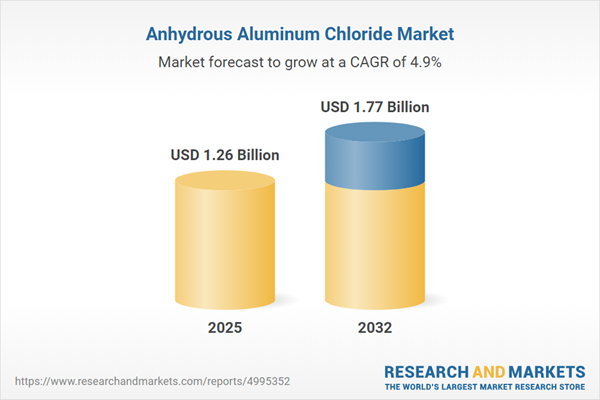Speak directly to the analyst to clarify any post sales queries you may have.
The anhydrous aluminum chloride market is experiencing notable transformation as sustainability-focused innovations and supply chain optimization reshape procurement and production strategies. Strategic insights are essential for leaders navigating evolving compliance standards and the expanding range of applications in this sector.
Market Snapshot: Anhydrous Aluminum Chloride Market Size and Growth
In 2024, the anhydrous aluminum chloride market was valued at USD 1.20 billion, rising to USD 1.26 billion in 2025. Sustained market momentum, driven by adoption across chemical synthesis, petrochemical processes, and pharmaceutical manufacturing, is reflected in a compound annual growth rate (CAGR) of 4.94%, with the market poised to reach USD 1.77 billion by 2032. Heightened activity around operational improvements and broadening end-use adoption underpin this expansion.
Scope & Segmentation
This report delivers thorough coverage of the anhydrous aluminum chloride market, giving decision-makers detailed views on segment performance, regional shifts, and technological integration for effective benchmarking and future-proofing.
- Product Types: Flakes, granules, and powder, each offering distinct surface area and dissolution characteristics that impact catalyst efficiency and process suitability.
- Purity Grades: Industrial grade satisfies bulk manufacturing requirements, while reagent grade meets stringent criteria for specialty and research-driven applications.
- Applications: Utilization spans chemical synthesis, key petrochemical reactions such as alkylation and isomerization, processes like polymerization, and pharmaceutical operations for both bulk drug production and intermediates synthesis.
- End Uses: Tailored solutions serve chemical manufacturing, dynamic pharmaceutical sectors, and research laboratories, supporting unique requirements in terms of scale, purity, and batch consistency.
- Distribution Channels: Timely supply is supported by direct sales, established regional distributors, and growing online retail options, which enhance responsiveness to changing market demand.
- Region Coverage: Detailed analysis is provided for the Americas (including North America and Latin America), Europe, Middle East & Africa, and Asia-Pacific, with country-specific trends, local compliance standards, and advancements in regional production capabilities.
- Company Profiles: Leading sector players such as BASF SE, Akzo Nobel N.V., Solvay S.A., Saudi Basic Industries Corporation, Showa Denko K.K., Koura Group, Inc., Gujarat Alkalies and Chemicals Limited, LC Industrial Chemicals India Private Limited, Tanfac Industries Limited, and KMG Chemicals, Inc. are profiled, with emphasis on competitive positioning and market innovation.
Key Takeaways for Senior Decision-Makers
- Adoption of new catalyst technology and digital process automation is redefining process reliability, supporting consistently high-quality outputs and improved operational sustainability across applications.
- Supply networks are favoring partners that demonstrate agility and transparency in sourcing, aiding enterprises as they manage increased regulatory attention and heightened sustainability expectations.
- Product differentiation through features such as ultra-low moisture content and specialized particle sizes is becoming a main factor for suppliers aiming to address complex, application-driven market requirements.
- Strategic collaboration, including joint R&D for advanced catalyst systems or manufacturing advances, accelerates the deployment of next-generation solutions and increases speed to market.
- Production is shifting regionally, with logistics strategies evolving to control cost volatility and protect market access amid changes in global trade parameters.
- Diversifying availability of purity and delivery forms ensures suppliers remain relevant to both large industrial purchasers and specialized, research-focused customers.
Tariff Impact and Supply Chain Realignment
The 2025 revision of United States tariff schedules has significantly influenced supply chain configuration and sourcing behaviors. Organizations are actively mitigating rising input costs by forming new relationships with regional manufacturers outside affected zones and renegotiating logistics contracts. Major producers are strategically expanding select facilities and establishing new alliances, making the procurement landscape more complex and dynamic. These developments are prompting downstream stakeholders to employ forward-purchasing tactics and adopt advanced inventory management, resulting in deeper market diversity and greater emphasis on responsive, adaptive supply networks.
Methodology & Data Sources
The study integrates primary research—through interviews with executives, technical specialists, and end users in the chemical and pharmaceutical fields—with secondary analysis from trade publications, regulatory filings, patents, and company disclosures. Findings are vetted by subject matter experts and validated with both competitive landscape and SWOT frameworks.
Why This Report Matters
- Enables senior leaders to identify investment strategies and manage risk by connecting market segmentation to evolving regulations.
- Provides actionable intelligence on process technology developments and supply chain innovations, supporting well-informed procurement and operational decisions.
- Facilitates strategic benchmarking based on exhaustive company profiles and up-to-date country coverage, empowering teams to assess their stance in a rapidly shifting competitive environment.
Conclusion
This analysis offers executives clear, actionable guidance on navigating the anhydrous aluminum chloride market’s technological evolution and supply chain transformation. Ongoing innovation and operational resilience are vital for maintaining growth and competitive strength.
Additional Product Information:
- Purchase of this report includes 1 year online access with quarterly updates.
- This report can be updated on request. Please contact our Customer Experience team using the Ask a Question widget on our website.
Table of Contents
3. Executive Summary
4. Market Overview
7. Cumulative Impact of Artificial Intelligence 2025
List of Figures
Samples

LOADING...
Companies Mentioned
The key companies profiled in this Anhydrous Aluminum Chloride market report include:- BASF SE
- Akzo Nobel N.V.
- Solvay S.A.
- Saudi Basic Industries Corporation
- Showa Denko K.K.
- Koura Group, Inc.
- Gujarat Alkalies and Chemicals Limited
- LC Industrial Chemicals India Private Limited
- Tanfac Industries Limited
- KMG Chemicals, Inc.
Table Information
| Report Attribute | Details |
|---|---|
| No. of Pages | 181 |
| Published | October 2025 |
| Forecast Period | 2025 - 2032 |
| Estimated Market Value ( USD | $ 1.26 Billion |
| Forecasted Market Value ( USD | $ 1.77 Billion |
| Compound Annual Growth Rate | 4.9% |
| Regions Covered | Global |
| No. of Companies Mentioned | 11 |









